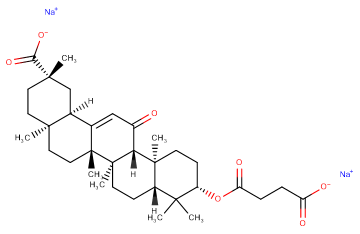 Home -
Products -
Cytoskeleton/Cell Adhesion Molecules -
Gap Junction Protein -
Carbenoxolone disodium
Home -
Products -
Cytoskeleton/Cell Adhesion Molecules -
Gap Junction Protein -
Carbenoxolone disodium

Carbenoxolone disodium
CAS No. 7421-40-1
Carbenoxolone disodium( Biogastrone | Bioral | Carbenoxolone sodium | Duogastrone | Pyrogastrone | Sanodin )
Catalog No. M15836 CAS No. 7421-40-1
An agent derived from licorice root. It is used for the treatment of digestive tract ulcers, especially in the stomach. Antidiuretic side effects are frequent, but otherwise the drug is low in toxicity.
Purity : >98% (HPLC)
 COA
COA
 Datasheet
Datasheet
 HNMR
HNMR
 HPLC
HPLC
 MSDS
MSDS
 Handing Instructions
Handing Instructions
| Size | Price / USD | Stock | Quantity |
| 25MG | 59 | In Stock |


|
| 50MG | 87 | In Stock |


|
| 100MG | 149 | In Stock |


|
| 200MG | Get Quote | In Stock |


|
| 500MG | Get Quote | In Stock |


|
| 1G | Get Quote | In Stock |


|
Biological Information
-
Product NameCarbenoxolone disodium
-
NoteResearch use only, not for human use.
-
Brief DescriptionAn agent derived from licorice root. It is used for the treatment of digestive tract ulcers, especially in the stomach. Antidiuretic side effects are frequent, but otherwise the drug is low in toxicity.
-
DescriptionAn agent derived from licorice root. It is used for the treatment of digestive tract ulcers, especially in the stomach. Antidiuretic side effects are frequent, but otherwise the drug is low in toxicity.
-
In VitroCell Viability Assay Cell Line:HaCaT cells Concentration:6 μM, 12 μM, 30 μM, 60 μM, 150 μM Incubation Time:Pre-treatment 1 hour Result:Had no toxicity until 48 hours at high dose in virus-infected cells. Western Blot Analysis Cell Line:HaCaT cells Concentration:30 μM Incubation Time:Pre-treatment 1 hour Result:Presented an obvious upregulation of A27.
-
In Vivo——
-
SynonymsBiogastrone | Bioral | Carbenoxolone sodium | Duogastrone | Pyrogastrone | Sanodin
-
PathwayCytoskeleton/Cell Adhesion Molecules
-
TargetGap Junction Protein
-
RecptorGap Junction Protein
-
Research AreaInflammation/Immunology
-
IndicationPsoriasis
Chemical Information
-
CAS Number7421-40-1
-
Formula Weight614.72
-
Molecular FormulaC34H48Na2O7
-
Purity>98% (HPLC)
-
SolubilityWater: 100 mM
-
SMILESCC(C)([C@](CC[C@@]([C@@]1(CC[C@]2(CC[C@](C([O-])=O)(C[C@]2(C1=C3)[H])C)C)C)4C)5[H])[C@@H](OC(CCC([O-])=O)=O)CC[C@]5(C)[C@@]4([H])C3=O.[Na+].[Na+]
-
Chemical Namesodium (2S,4aS,6aS,6bR,8aR,10S,12aS,12bR,14bR)-10-((3-carboxylatopropanoyl)oxy)-2,4a,6a,6b,9,9,12a-heptamethyl-13-oxo-1,2,3,4,4a,5,6,6a,6b,7,8,8a,9,10,11,12,12a,12b,13,14b-icosahydropicene-2-carboxylate
Shipping & Storage Information
-
Storage(-20℃)
-
ShippingWith Ice Pack
-
Stability≥ 2 years
Reference
1.Hausmann W, Tárnoky AL. Br J Pharmacol ChemOthers. 1966 Feb;26(2):412-20.
molnova catalog



related products
-
Gap 26
Gap 26 is a mimetic peptide corresponding to the residues 63-75 of connexin 43 which is a gap junction blocker.
-
TAT-Gap19
Cx43 hemichannel blocker (IC50 ~7 μM). No significant affinity for gap junctions or Panx1 channels. N-terminal transactivator of transcription (TAT) motif promotes membrane permeability and increases inhibitory effect of Gap19. Active in vivo. Brain penetrant.
-
GAP-134 hydrochlorid...
A potent, orally active gap-junction modifier; prevents significantly conduction velocity slowing at 10 nM compared with vehicle.



 Cart
Cart
 sales@molnova.com
sales@molnova.com

